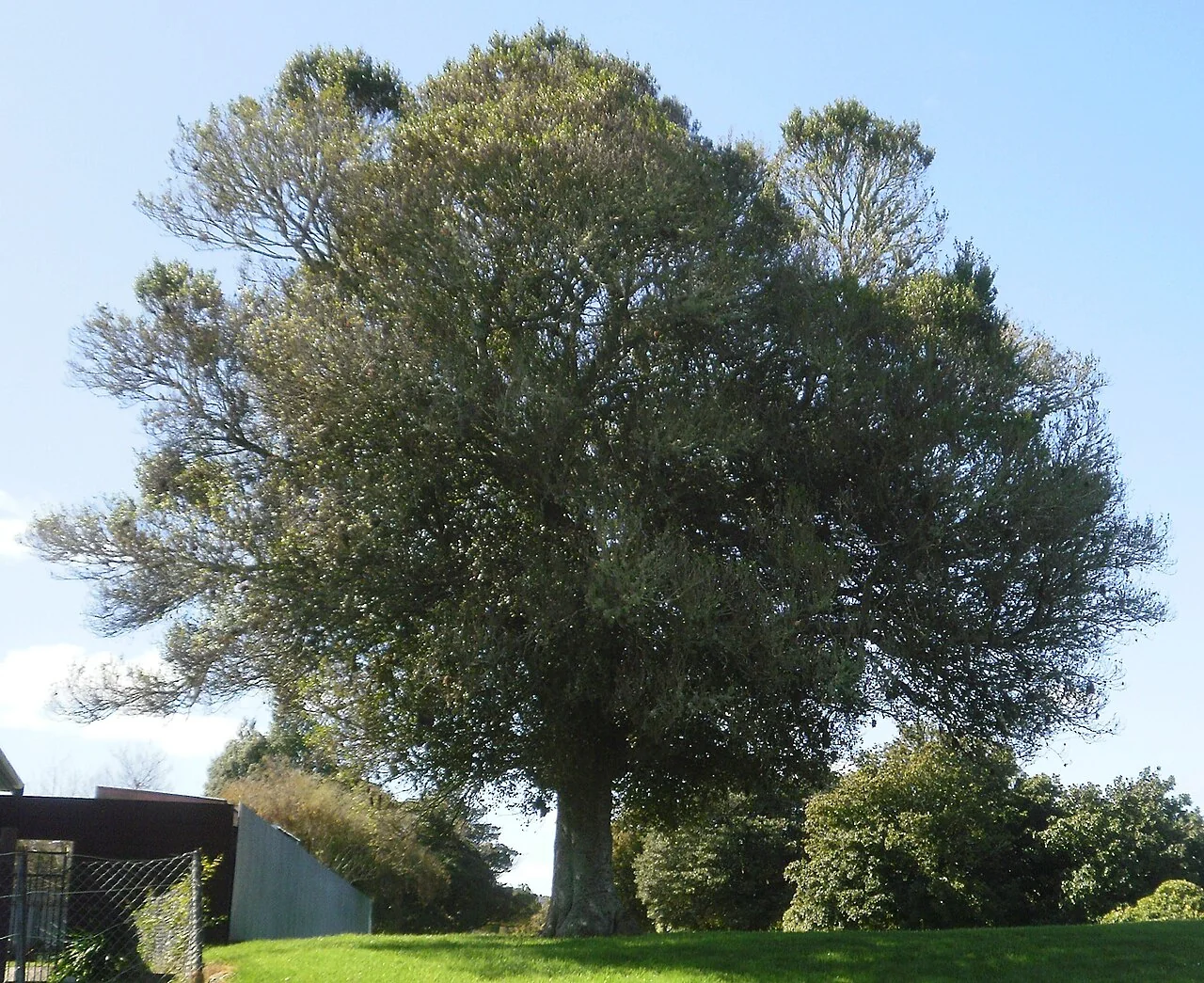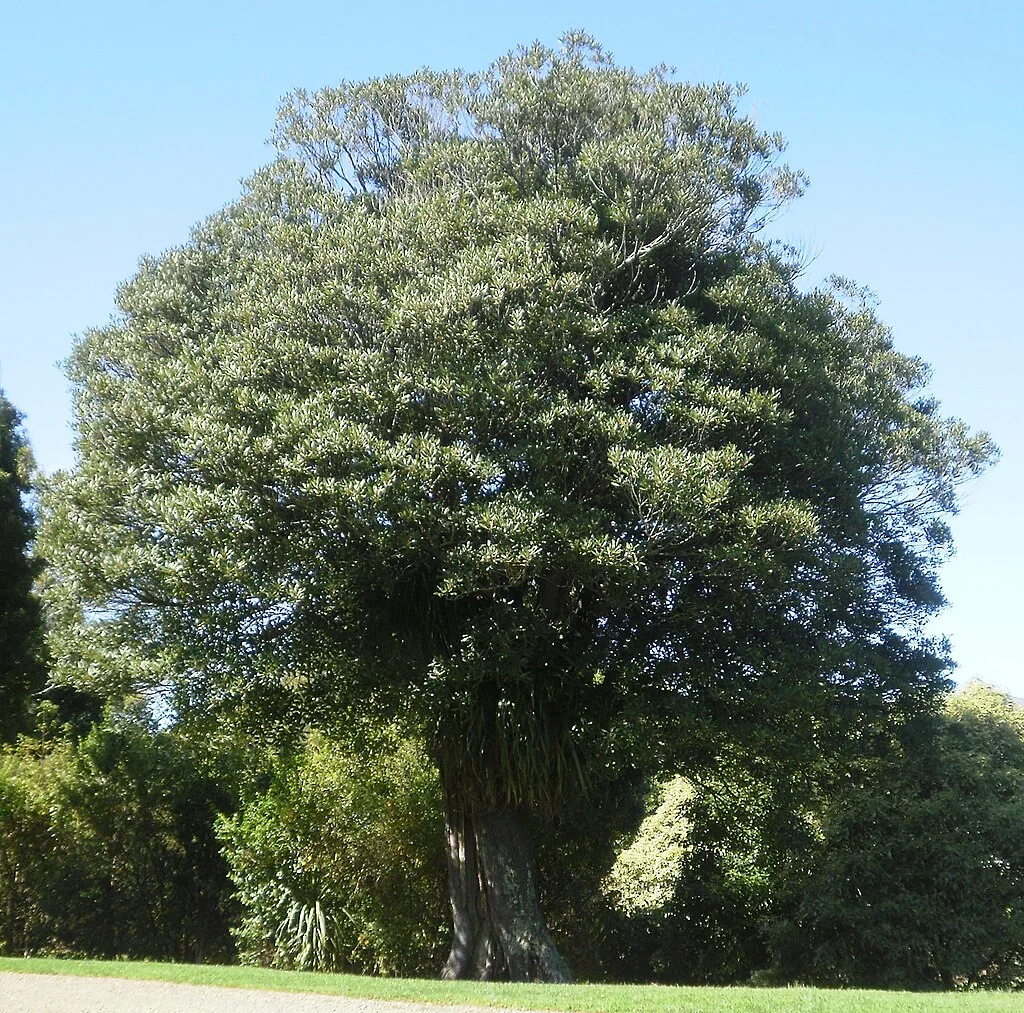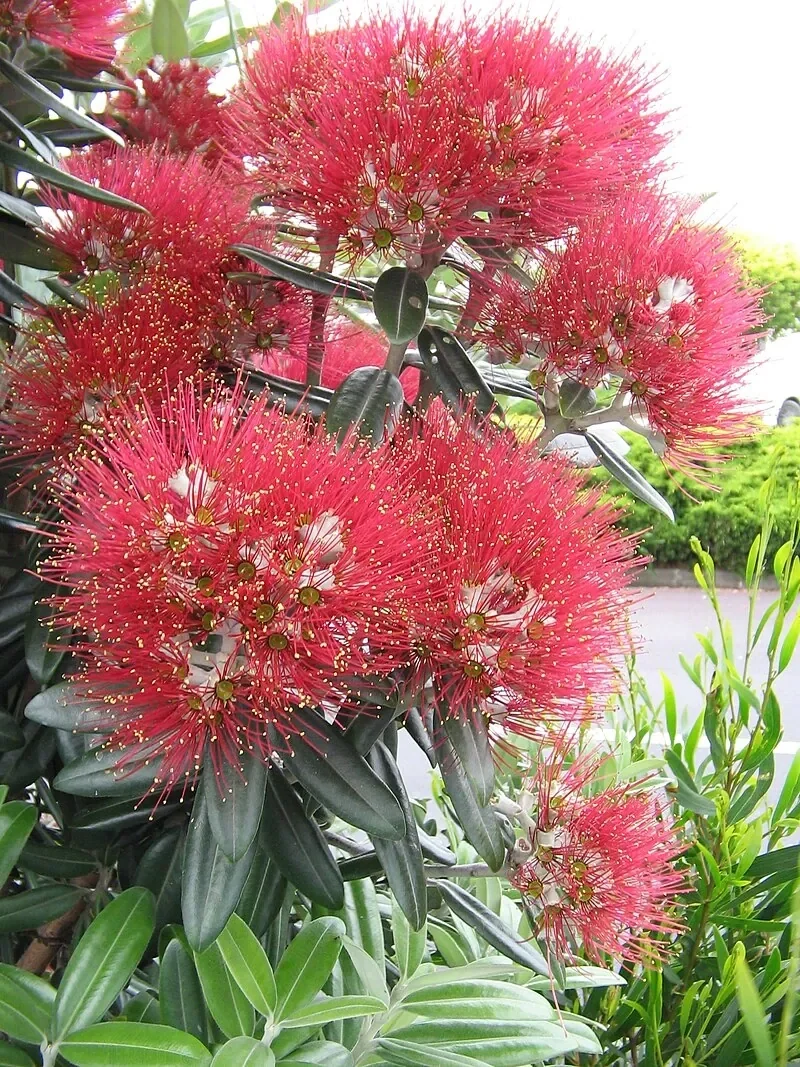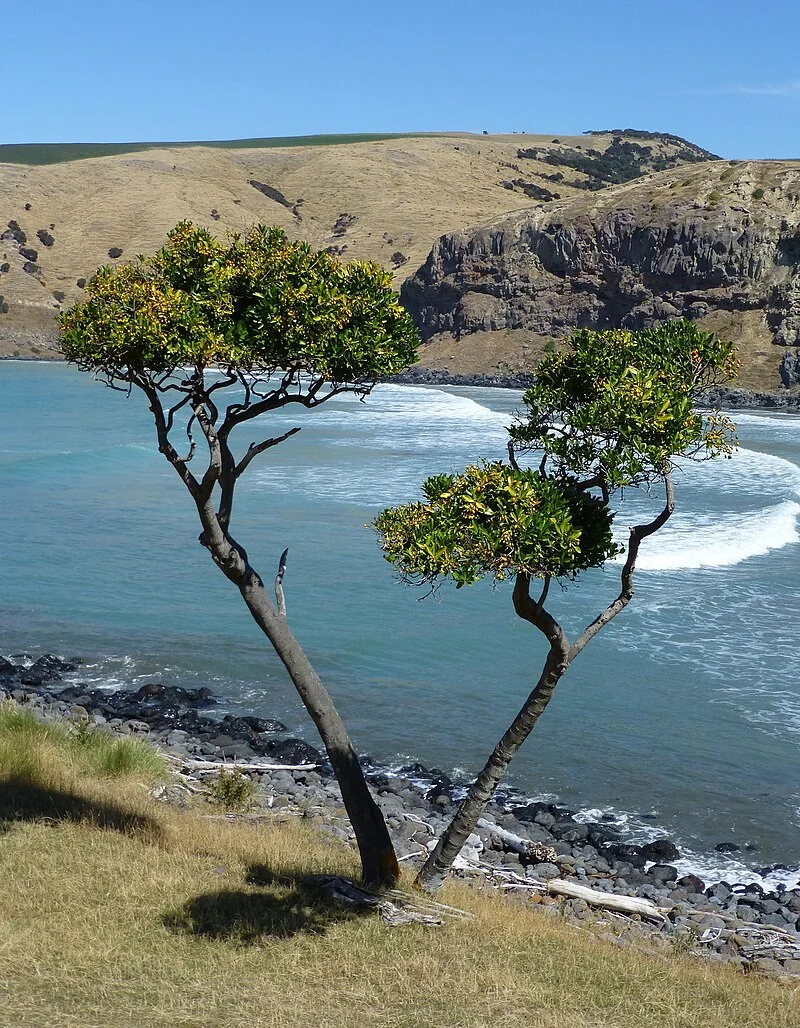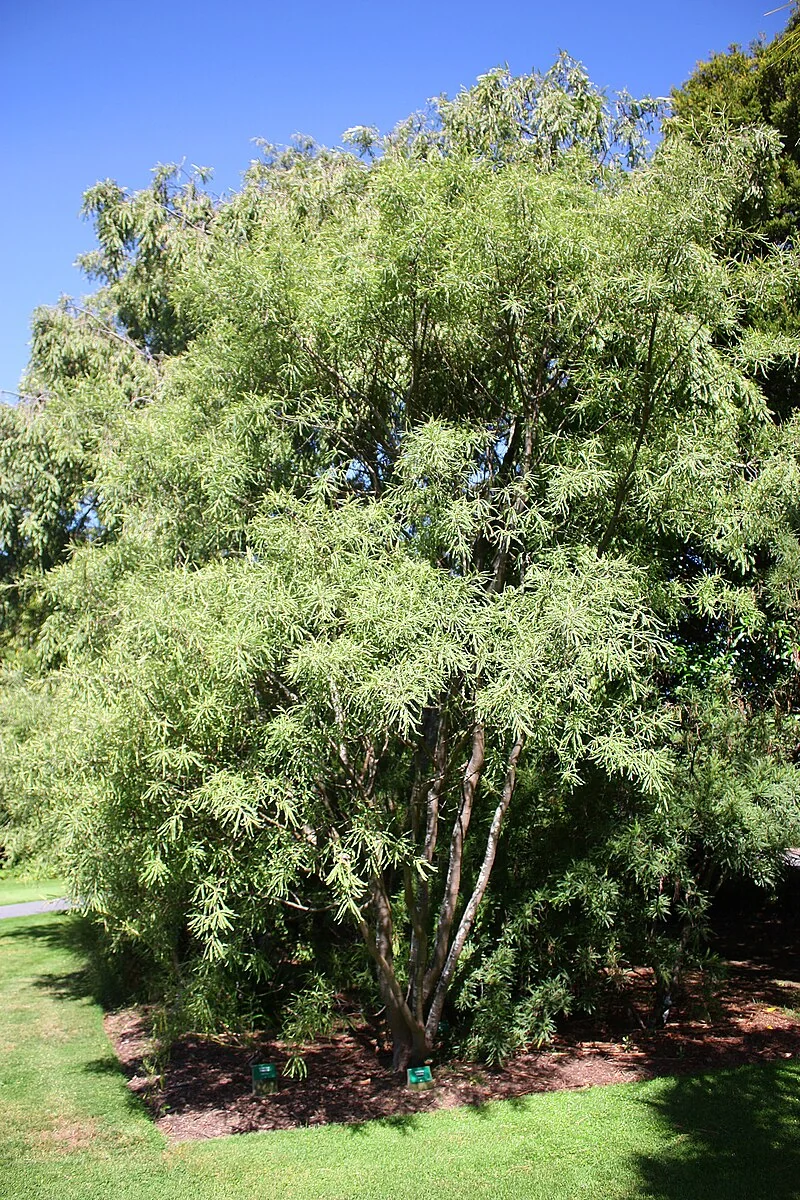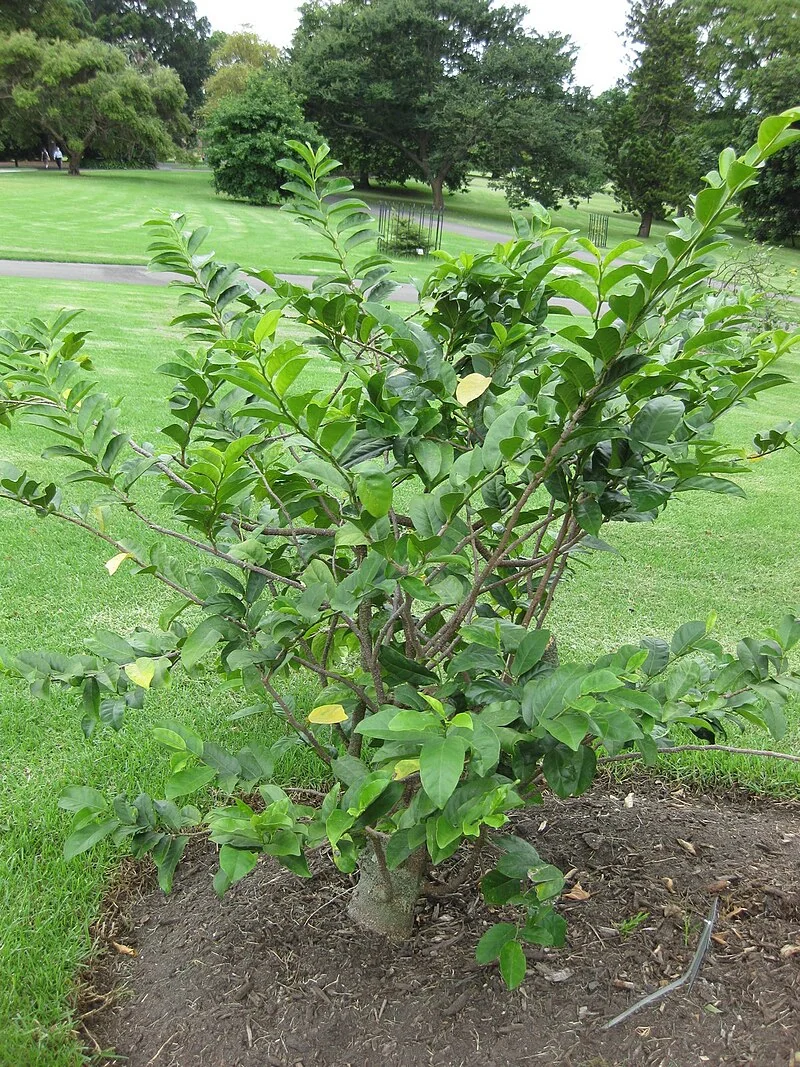
Three Kings Milk Tree
Streblus smithii
The Three Kings milk tree (scientific name: Streblus smithii) is a remarkable endemic species found exclusively on the remote Three Kings Islands north of New Zealand. Also known as Smith's milkwood, this unique tree represents one of New Zealand's rarest native plants, characterized by its distinctive milky sap, large glossy leaves, and tropical appearance. This comprehensive guide explores its botanical features, conservation significance, and cultivation requirements for those fortunate enough to encounter this extraordinary member of New Zealand's native trees and threatened species.

Plant Description
Streblus smithii is a distinctive small tree or shrub that typically reaches 3-5 metres in height, occasionally growing up to 8 metres under optimal conditions. The plant exhibits a spreading, bushy habit with dark brown bark marked by conspicuous raised lenticels (breathing pores). One of its most notable characteristics is the thick, white, milk-like sap that exudes when the bark is cut or damaged, giving rise to its common name.
The leaves are particularly striking - large, leathery, and glossy dark green, measuring 10-20 cm in length and up to 12 cm in width. They are entire-margined with an ovate to elliptic-oblong shape, featuring a rounded to obliquely cordate base and obtuse to subacute tips. The leaves are arranged alternately on stout petioles up to 15 mm long, creating an attractive tropical appearance that sets this species apart from most other New Zealand natives.
The flowers are arranged in solitary or paired spikes measuring 5-12 cm long, with small perianth segments approximately 3-4 mm in diameter. These develop into bright red, globose drupes (fruits) that are 8-9 mm in diameter, providing an attractive display and important food source for wildlife.
Quick Facts
| Scientific Name | Streblus smithii |
|---|---|
| Height | 3-5m (occasionally 8m) |
| Spread | 2-4m |
| Water Needs | Moderate to high |
| Light | Full sun to part shade |
| Frost Tolerance | Frost tender |
| Salt Tolerance | High (coastal native) |
| Growth Rate | Slow to medium |
| Lifespan | Long-lived |
Climate Best Suited to
The Three Kings milk tree (Streblus smithii) originates from the subtropical climate of the Three Kings Islands, requiring warm, humid conditions with protection from frost. Its natural habitat experiences mild winters and warm, humid summers with consistent rainfall. The species is frost-tender and performs best in coastal or near-coastal environments with moderate to high humidity levels. In cultivation, it requires protection from cold winds and frost, making it most suitable for warmer regions of New Zealand.
Regional Suitability
| City | Climate Suitability |
|---|---|
| Whangārei | Ideal |
| Auckland | Ideal |
| Hamilton | Good |
| Tauranga | Ideal |
| Rotorua | Moderate |
| Gisborne | Good |
| New Plymouth | Good |
| Napier | Moderate |
| Whanganui | Moderate |
| Palmerston North | Moderate |
| Wellington | Moderate |
| Nelson | Good |
| Christchurch | Poor |
| Dunedin | Poor |
| Invercargill | Poor |
Plant Habitat
In its natural environment, Streblus smithii inhabits the coastal and lowland forests of the Three Kings Islands, preferring deep, fertile soils often found on alluvial terraces. The species demonstrates remarkable adaptability within its limited range, capable of growing on steep cliff faces, rock ledges, and even as stunted shrubs on cobble and boulder beaches when conditions are challenging.
The Three Kings Islands experience a subtropical climate with high humidity, moderate rainfall, and protection from extreme weather by their isolated oceanic position. The natural habitat features volcanic soils with good drainage, consistent moisture from sea breezes, and protection from harsh winds in forest understoreys or sheltered valleys.
This adaptation to coastal conditions means the species can tolerate salt spray and somewhat drier conditions than might be expected, though it performs best with consistent moisture and protection from the harshest elements. The plant's ability to grow in both forest understoreys and more exposed coastal situations demonstrates its ecological versatility within its restricted range.
Plant Conservation
Streblus smithii is one of New Zealand's most geographically restricted endemic species, found exclusively on the Three Kings Islands. This extremely limited distribution makes it inherently vulnerable to environmental changes, habitat disturbance, and potential extinction. The species faces ongoing conservation challenges due to its small population size and restricted range, making it a critical priority for threatened species conservation.
The Three Kings Islands have experienced significant ecological changes since human settlement, including the introduction of grazing animals and various plant species that have altered the native ecosystem. While some restoration efforts have been undertaken, the remote location of the islands makes ongoing conservation work challenging and expensive.
Conservation efforts focus on habitat protection, monitoring of existing populations, and ex-situ cultivation programs to maintain genetic diversity. The species is of high priority for botanical gardens and specialist native plant nurseries, though its cultivation requirements and slow growth make it challenging to establish in cultivation. Research into propagation techniques and habitat requirements continues to inform conservation strategies.
Growing Requirements
Soil Requirements
Three Kings milk tree (Streblus smithii) requires rich, well-drained soil that closely mimics its native volcanic island conditions. The species performs best in deep, fertile soils with excellent drainage, as it cannot tolerate waterlogged conditions. A slightly acidic to neutral pH is preferred, with the addition of organic matter being beneficial for establishment and long-term health.
- Requires rich, fertile, well-draining soil with high organic content
- Cannot tolerate waterlogged or poorly-draining conditions
- Prefers slightly acidic to neutral pH (6.0-7.0)
- Benefits from incorporation of compost and volcanic materials if available
- Needs protection from root competition from aggressive plants
Light Requirements
Streblus smithii demonstrates flexibility in its light requirements, adapting to both full sun and partial shade conditions. In cultivation, it typically performs best with morning sun and afternoon protection, particularly in hotter climates. The species can tolerate full sun in coastal conditions where humidity levels remain high, but may require some shade protection inland.
- Tolerates full sun to partial shade conditions
- Morning sun with afternoon protection often ideal
- Benefits from dappled light in hot, dry climates
- Can handle full sun in high-humidity coastal environments
Water Requirements
Water requirements are moderate to high, reflecting the species' origin from the humid Three Kings Islands environment. Consistent soil moisture is essential, particularly during establishment, though the plant cannot tolerate waterlogged conditions. Regular deep watering during dry periods helps maintain the lush tropical appearance and healthy growth that characterizes this species.
- Requires consistent soil moisture, especially when establishing
- Cannot tolerate drought conditions or extended dry periods
- Deep, infrequent watering preferred over frequent shallow watering
- Benefits from high humidity - consider misting in dry climates
- Mulching helps retain soil moisture and regulate temperature
Planting Guide
Planting Streblus smithii requires careful attention to site selection and preparation, given its specific requirements and conservation status. Choose a location with protection from strong winds and frost, ensuring adequate space for the plant's spreading growth habit. The planting site should receive morning sun with some afternoon protection in hotter climates.
Prepare the planting hole to twice the width of the root ball and incorporate generous amounts of compost and well-aged organic matter. Plant at the same depth as in the container, water thoroughly after planting, and apply a thick layer of organic mulch around the base, keeping it away from the trunk. Regular monitoring during the first year is essential to ensure successful establishment.
Due to its rarity and slow growth, Streblus smithii is typically only available from specialist native plant nurseries or botanical collections. Young plants may take several years to establish and show significant growth, requiring patience and consistent care. Protection from competing vegetation and browsing animals is particularly important during the establishment phase.
Ecological Role
Within its native Three Kings Islands ecosystem, Streblus smithii plays a crucial role as both a canopy component in forest communities and as a food source for native wildlife. The bright red fruits are particularly important for seabirds and any native birds present on the islands, providing essential nutrition during fruiting seasons.
As a member of the fig family (Moraceae), the species likely has important relationships with pollinators, though the specific insects involved in its Three Kings Islands habitat may differ from mainland New Zealand fauna. The large leaves contribute significant organic matter to the forest floor when they fall, helping to build soil structure and provide habitat for invertebrates.
The plant's ability to grow in various microhabitats - from forest understoreys to coastal cliff faces - makes it an important stabilizing species in the Three Kings ecosystem. Its root system helps prevent erosion on steep slopes, while its canopy provides shelter for smaller plants and animals in the challenging island environment.
Uses & Significance
Garden Uses
Three Kings milk tree (Streblus smithii) is an exceptional specimen plant for collectors of rare New Zealand natives and those interested in conservation horticulture. Its striking tropical appearance, featuring large glossy leaves and distinctive growth habit, makes it a conversation piece in suitable gardens. Best suited to coastal gardens or warm, sheltered locations with high humidity.
- Outstanding specimen tree for rare plant collections
- Suitable for conservatories or protected courtyard gardens
- Excellent for botanical education and conservation awareness
- Ideal for coastal gardens in frost-free areas
- Valuable for habitat restoration projects on offshore islands
Streblus smithii holds special significance as one of New Zealand's rarest endemic plants, representing the unique biogeography of the Three Kings Islands. Named in honour of either Stephenson Percy Smith, who accompanied Thomas Cheeseman to the Three Kings Islands in 1887, or the English botanist John Smith, the species embodies the history of botanical exploration in New Zealand's remote locations.
- Represents the unique flora of New Zealand's offshore islands
- Important in the history of New Zealand botanical exploration
- Symbol of the need for conservation of endemic species
- Educational value for understanding island biogeography
Conservation Value
The conservation value of Streblus smithii cannot be overstated - as one of New Zealand's most geographically restricted endemics, every individual plant represents irreplaceable genetic diversity. Cultivation of this species in botanical gardens and private collections serves as an insurance population against potential extinction in the wild, while raising awareness about the vulnerability of island endemic species.
- Critical importance for maintaining genetic diversity of the species
- Living example of the vulnerability of island endemic species
- Research opportunities for understanding island plant evolution
- Educational tool for conservation biology and threatened species management
Landscaping Uses
Due to its rarity and specific growing requirements, Streblus smithii is primarily suited to specialist collections and conservation-focused gardens rather than general landscaping applications. When used in appropriate settings, it serves as an exceptional focal point, particularly in tropical-style gardens or collections of rare New Zealand plants.
The plant's striking foliage and unique growth habit make it ideal for creating dramatic contrasts with other New Zealand natives, particularly when paired with ferns or smaller-leaved species. In suitable microclimates, it can be used to create a subtropical ambiance in courtyard gardens or as a centerpiece in protected native plant collections.
For botanical institutions and serious collectors, Streblus smithii represents an opportunity to showcase New Zealand's remarkable endemic flora while contributing to conservation efforts through ex-situ cultivation. Its slow growth and specific requirements make it unsuitable for impatient gardeners, but rewarding for those committed to long-term horticultural projects.
Seasonal Care Calendar
Spring
Spring marks the beginning of active growth for Three Kings milk tree (Streblus smithii). New foliage emerges with fresh, glossy leaves, and it's an ideal time for repotting container plants or planting new specimens. Ensure consistent moisture as growth accelerates and monitor for any pest activity on the tender new growth.
- New growth begins with fresh, large leaves emerging
- Ideal time for planting or transplanting if necessary
- Apply slow-release fertilizer suitable for native plants
- Increase watering as growth activity increases
- Monitor for scale insects or other pests on new growth
Summer
Summer is the peak growing season for Three Kings milk tree (Streblus smithii), with flowering typically occurring during this period. Consistent watering becomes crucial, especially in hot weather, and protection from extreme heat may be necessary. The plant's tropical nature means it thrives in the warm, humid conditions of summer.
- Peak growing season with maximum foliage development
- Flowering occurs in summer with distinctive spike inflorescences
- Regular, deep watering essential during hot weather
- Consider shade cloth protection in extreme heat
- Maintain high humidity around the plant
Autumn
During autumn, Three Kings milk tree (Streblus smithii) develops its distinctive bright red fruits, providing an attractive display. Growth begins to slow as temperatures moderate, and it's an excellent time for propagation activities if fruits are available. Gradually reduce watering frequency as growth slows.
- Bright red fruits develop and ripen, attracting birds
- Growth rate naturally slows as temperatures drop
- Excellent time for seed collection if fruits are present
- Begin reducing watering frequency
- Good time for light pruning if needed
Winter
Winter requires careful protection for Three Kings milk tree (Streblus smithii) due to its frost-tender nature. In colder regions, container plants may need to be moved to protected locations, while garden plants require frost protection. Minimal watering is needed during this dormant period.
- Requires frost protection - move containers under cover if needed
- Growth is minimal during the cooler months
- Reduce watering significantly but don't allow to dry completely
- Monitor for cold damage on exposed foliage
- Avoid fertilizing during dormant period
When to Prune and How Much
Three Kings milk tree (Streblus smithii) naturally develops an attractive spreading form and requires minimal pruning to maintain its shape. Pruning should be approached conservatively, focusing primarily on removing dead, damaged, or diseased branches to maintain plant health. The species' slow growth rate means that any pruning cuts take time to recover.
- Remove dead, damaged, or diseased branches at any time of year
- Light formative pruning when young to encourage good structure
- Prune immediately after flowering to avoid removing next season's flower buds
- Remove any growth that appears weak or poorly positioned
- Minimal pruning required due to naturally attractive growth habit
- Avoid heavy pruning as recovery is slow due to the plant's growth rate
When pruning, always use clean, sharp tools sterilized with alcohol to prevent disease transmission. The milky sap can be sticky and may irritate skin, so wear gloves when handling cut branches. Make clean cuts just above a healthy leaf node or branch junction to encourage proper healing and minimize the risk of disease entry.
How to Grow Three Kings Milk Tree
From Seed
Propagating Three Kings milk tree (Streblus smithii) from seed offers the best chance of success, though seeds are rarely available due to the species' limited distribution. Fresh seeds have the highest viability and should be sown as soon as possible after collection. Seeds lose viability quickly if allowed to dry out, so immediate processing is critical for success. The fruit's fleshy exterior contains germination inhibitors that must be thoroughly removed to ensure successful establishment.
- Collect ripe red fruits when they are fully mature and soft to the touch
- Remove the fleshy fruit pulp immediately and clean seeds thoroughly in lukewarm water
- Gently rub seeds to remove all pulp residue and any germination inhibitors
- Surface sterilize seeds with diluted fungicide to prevent damping-off diseases
- Sow immediately in sterile seed-raising mix with exceptional drainage properties
- Use specialized containers that allow careful moisture monitoring without disturbance
- Maintain consistent moisture levels - never waterlogged but never completely dry
- Provide controlled temperature between 20-25°C using heated propagation mats
- Maintain high humidity (70-80%) using clear covers or misting systems
- Provide bright, filtered light without direct sun exposure to prevent overheating
- Monitor daily for signs of germination, which can be highly irregular
- Exercise extreme patience as germination may take anywhere from 4-16 weeks
- Transplant only when seedlings have developed their second set of true leaves
- Use smallest possible containers initially to minimize root disturbance
Due to the species' critical conservation status, any successful seed propagation should be meticulously documented with detailed records of collection dates, germination rates, and growing conditions. Consider collaborating with botanical institutions such as Auckland Botanic Gardens or Wellington Botanic Gardens, which have specialized rare species programs. Genetic diversity is crucial for this endangered species, so maintaining detailed records of seed sources helps preserve the limited gene pool available.
From Cuttings
Vegetative propagation from cuttings is challenging but possible with Streblus smithii, requiring careful attention to technique and environment. Semi-hardwood cuttings taken in late summer have the best success rate, when the current year's growth has begun to mature but still retains some flexibility. The species' slow growth and specialized requirements mean that cutting propagation demands considerable patience and optimal conditions throughout the extended rooting period.
- Select healthy, non-flowering shoots from current season's growth in late summer
- Take semi-hardwood cuttings 10-15cm long ensuring each has at least 3-4 nodes
- Make clean cuts with sterile, sharp secateurs to minimize tissue damage
- Remove lower leaves and trim remaining leaves by half to reduce transpiration
- Trim the cut end cleanly just below a leaf node using a sharp blade
- Apply fungicide to prevent rot during the extended rooting period
- Dip cutting tips in high-strength rooting hormone (8000-10000ppm IBA)
- Plant in specialized free-draining propagation mix containing perlite and pine bark
- Use propagation trays with clear covers to maintain precise humidity control
- Install bottom heat systems to maintain consistent 22-25°C soil temperature
- Maintain high humidity (85-90%) but ensure adequate air circulation
- Provide bright, filtered light using shade cloth to prevent leaf scorch
- Monitor moisture levels daily - soil should be consistently moist but never saturated
- Exercise extreme patience as rooting typically takes 3-6 months minimum
- Look for new growth rather than testing for roots, which can damage fragile root systems
Cultivation Notes
Due to the conservation status and rarity of this species, propagation should ideally be undertaken by experienced growers or botanical institutions with appropriate facilities and expertise. The slow growth rate and specific requirements make this species challenging for casual propagation attempts.
Pests & Diseases
Three Kings milk tree (Streblus smithii) is generally resistant to most common pests and diseases when grown in appropriate conditions. However, its rarity means that any pest or disease issues can be particularly serious. The most common problems arise from environmental stress, particularly from incorrect watering or unsuitable growing conditions.
Scale insects can occasionally affect the species, particularly when grown in protected environments with poor air circulation. Regular monitoring of the undersides of leaves and stems is important for early detection. Fungal issues may arise in poorly-draining soils or when overhead watering creates persistently damp foliage conditions.
Prevention is the best approach - maintaining optimal growing conditions, ensuring good air circulation, and avoiding water stress will minimize pest and disease problems. If issues do arise, gentle, organic treatments are preferable to harsh chemicals, given the species' potentially sensitive nature and conservation value.
Cultural Significance
Streblus smithii, endemic to the remote Three Kings Islands, represents a unique piece of New Zealand's natural heritage that predates human settlement. While the species lacks specific traditional uses due to its extremely limited distribution and the islands' isolation, it holds significance as part of the broader botanical taonga of Aotearoa. The Three Kings Islands (Manawa Tāwhi) were known to northern iwi as significant landmarks for navigation, and the unique flora there, including this milk tree, represents the evolutionary heritage of New Zealand before human arrival. In contemporary conservation terms, Streblus smithii symbolizes the importance of protecting our rarest endemic species and the fragile island ecosystems they depend upon.
- Endemic to culturally significant Three Kings Islands (Manawa Tāwhi)
- Represents pre-human evolutionary heritage
- Islands used as navigation landmarks by northern iwi
- Symbol of conservation importance for rare endemic species
- Part of New Zealand's unique botanical taonga
Bonus Tip
The milky sap that gives Three Kings milk tree its common name is not just for show - this latex-like substance may serve as a natural defense mechanism against herbivores and insects, helping protect the plant in its isolated island environment where every individual is precious for species survival.
